At the end of August, looking to escape the Tokyo summer heat, I took a highway bus from Shinjuku to Hakuba, the famous ski town in Nagano, for a three-day solo hike in the Hakuba Range.

My 3-day hiking route and planned alternate course, in case of adverse weather.
Day 1: Wednesday, August 30
Happo Ike Hut (八方池山荘) –> Karamatsudake Hut (唐松岳頂上山荘) (4.56km)
The 6:35 AM highway bus from Shinjuku Bus Terminal direct to Hakuba Happo Bus Terminal arrived on time at around 11:45 AM. First things first, I went to the Montbell store on the second floor of the bus terminal building to purchase a fuel canister. Then, I got directions and a bus schedule for post-hike logistics from the information counter.
To reach the beginning of my hike, I took the Adam Gondola and two ski lifts up Happo One (pronounced “oh-nay”, meaning ridge) Ski Resort. At the top of Adam Gondola, I purchased a Nozawana oyaki for lunch and ate it on the next lift up. (“Oyaki” is a Nagano specialty buckwheat steamed bun.) The lifts were set really low, and I swung my feet in the long grass. Dairy cows relaxed on the verdant green ski slopes.

The lifts got me up to Happo Ike Hut by 1 PM. Upon asking where to get water, I was informed it was 100 yen for up to two liters. I had 500 ml on me and should’ve filled up at the bottom of the mountain for free. Rookie mistake!
The weather forecast for the week was rainy, and when the bus had driven into Hakuba Valley the clouds were hanging low, covering to tops of the mountains on both sides of the valley. But by the time I reached Happo Ike pond at about 1:40 PM, the fog had begun to lift. I took a coffee break and enjoyed the reflection of the Hakuba range in the pond.

There’s a little shrine at Happo Ike to the dragon god who lives in the pond.
Beyond Happo Ike, you leave the tourists behind. Since I started hiking in the afternoon, I ran into only one other hiker on the way up to Karamatsudake Hut, where I camped for the night. He was an older gentleman who had driven up from Chiba in the morning, so we were on more or less the same schedule. Seeing the sleeping pad strapped to the outside of my pack, he asked if I was tent camping. He was curious how heavy my pack was. I said that the scale at the bottom of Happo One said 11 kilograms. He said his was 12 kg, and he was planning to stay at the hut, which meant he hadn’t packed food, tent, or sleeping bag… how come my pack was so light? Then, he realized he was carrying 2 kilograms worth of camera kit. I said, that totally explains it, because my tent is only 750 grams and my sleeping bag even less than that. That’s one benefit of having not gotten crazy about photography while hiking… yet.
I completed the anticipated 4-hour hike from Happo Ike Hut to Karamatsudake Hut in just about 3 hours. It’s a short hiking day, but I’d been up and traveling since 5 AM and was satisfied to call it a day. Welcomed by a sign offering draft beer, I checked-in and paid 1000 yen for a tent site. After a brief chat with the girl at reception about mountains in Taiwan, I set up camp. The campground consisted of scattered sites down the other side of the ridge from where I had climbed up, and offered amazing views of the Tateyama peaks dominated by Mt. Tsurugi.

Karamatsudake Hut

What my campsite looked like

View of Karamatsudake Hut and tent sites
I’m relaxing and unpacking and somehow 1.5 hours disappeared. I climbed back up the ridge to go to the hut to use the restrooms, then returned to my tent to cook dinner as sunset fell on the archipelago of the Kita Alps in a cotton candy sea.

Sunset on cloud-capped Mt. Tsurugi
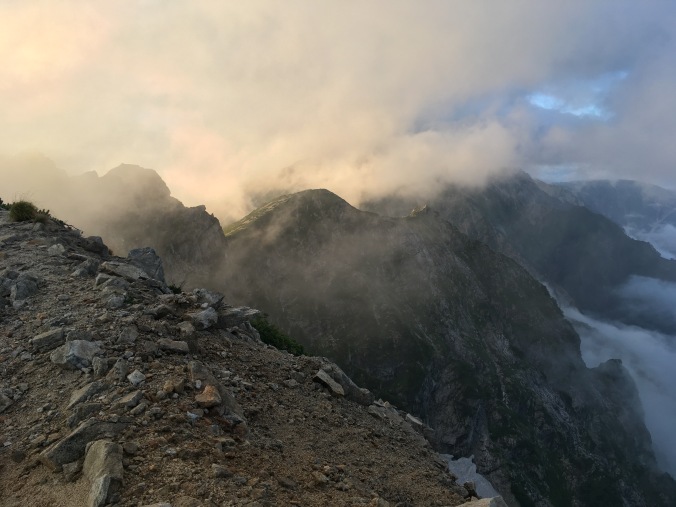
Scoping out the next day’s hike: looking north across Kaerazunoken
Day 2: Thursday, August 31
Karamatsudake Hut –> Hakubadake Chojo Shukusha (白馬岳頂上宿舎) (8.64km)
I am awakened in the middle of the night by rain inside my tent. It’s condensation being shaken off the inside of my tent by the wind blowing outside. I wiped down the inside of my tent with a small camp towel, changed the orientation of my head (since I had been sliding down toward one end of my tent) and slept much better for the rest of the night.
I had ambitious plans to wake up for sunrise but couldn’t actually motivate myself to get up. Anyway, when I finally got out of my tent there was pretty much zero visibility due to the mist. I packed up my tent and went to the hut to brush my teeth, pee, and make some coffee. Reception at the hut tried to sell me 1L of PET bottled water for 600 yen, but I purchased 1L of unfiltered river water for 150 yen and ran it through my Sawyer filter.
It was imperceptibly drizzling as I started the day’s hike and after about 20 minutes, I stopped for breakfast of a piece of Family Mart chocolate pound cake at the peak of Karamatsudake. It’s wrapper had conveniently puffed up into a balloon at high elevation to keep it from getting smushed in my pack.

400 calories of chocolatey goodness
The next section of the hike was a rocky traverse called Kaerazu no Ken (不帰の険), which translates to “Cliffs of No Return”. It looked pretty sketchy based on the trip reports I’d read on Yamareco and my map had a dotted line labeled “danger”. So, in case of heavy rain and low visibility, I had a plan B of going south from Mt. Karamatsu and taking an easier traverse to Mt. Goryu. I was walking among wisps of cloud, but it wasn’t raining so I decided to follow plan A and go for it. Just past the first sign marking the beginning of Kaerazu no Ken, the trail wasn’t too bad. A family of ptarmigan waddled down the trail in front of me, unperturbed by my presence. But soon I had put away my trekking poles and found myself traversing cliffs on chains and swinging around rocky corners trying to stay balanced with a bulky pack on my back. Finishing the traverse without falling to my death, I was rewarded with a huge slogging uphill climb on switchbacks and then some more chains to the top of Tengu no Kashira (天狗ノ頭). From the top of Tengu no Kashira, you could see that the peaks to the south were super rocky and steep compared to the rolling ridge to the north, which looked much less extreme.

Sign warning hikers of the start of Kaerazu no Ken

Ptarmigan

These chains will later make the cables at Half Dome a piece of cake

“I think the trail goes that way?”
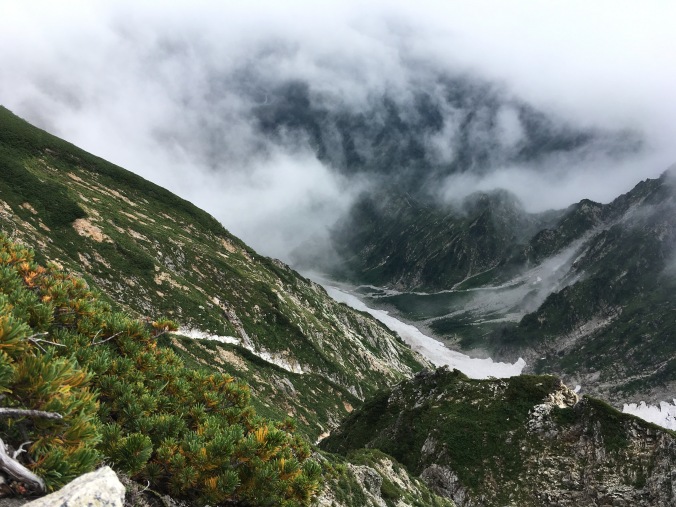
“Snow river” in the valley that will not melt through to the next snow season

View south of Tengu no Kashira

View north of Tengu no Kashira
I was pretty spent by the time I got to Tengu Hut. The clouds thinned and parted a bit and I quite successfully dried out my tent and aired out my feet over lunch at a picnic table in front of Tengu Hut.

Lunch, tent drying, and water-getting at Tengu Hut
However, by the time I started back on the trail again, the mist had dropped again and there was no visibility as I crossed the small snowfield after Tengu Hut, making it a bit scary as I couldn’t see where I was going. Then, there was a climb up brilliant white marble (?) scree to the top of Hakuba-Yarigatake. Since there was still no visibility, I took the easy route around Sakushidake (杓子岳) instead of summiting another peak. Past the Hakuba saddle there were supposed to be alpine flower meadows, but I couldn’t really see anything. I finally spotted a sign for the municipal run Hakubadake Chojo Shukusha hut (白馬岳頂上宿舎), paid my 1000 yen to camp out back and warmed up in the restaurant.
Day 3: Friday, September 1
Hakubadake Chojo Shukusha –> Tsugaike Shisenen Ropeway Station (6km)
Sometime during the night, I pulled my Buff down over my eyes and ended up sleeping past sunrise again. It was the coldest night I’d spent so far in my tent and sleeping bag, and when I awoke I stuffed my hiking clothes inside my sleeping bag to warm them up and unzipped the mesh door of my tent to my heat up some breakfast in the vestibule of my tent while still sitting in my sleeping bag. It’s a brilliant blue sunny sky out. Darn it! I missed a beautiful sunrise. After eating, I zipped my tent back up and put on my now toasty warm hiking clothes. The sun was just beginning to warm my tent as well, as I pushed my pack out through the tent door, collapsed the tent and collected my tent stakes. The tent was pretty dry from the sunny morning, so I didn’t have to worry about drying it during the day.
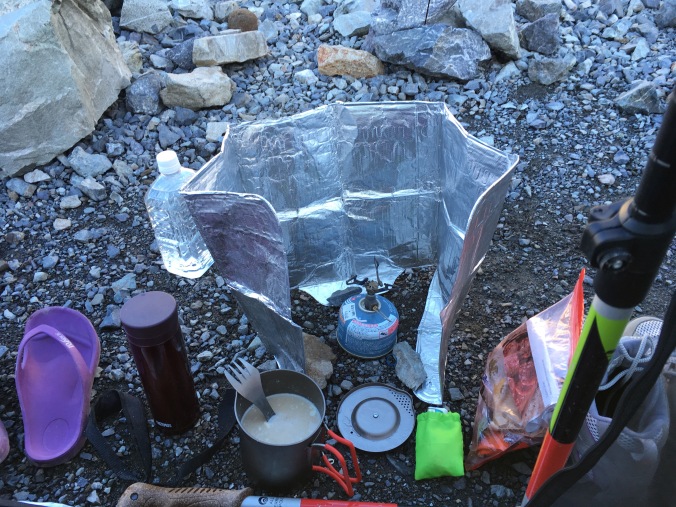
Breakfast
I made my way up to the top of Mt. Shirouma. There is a another huge hut right there! Yesterday, I couldn’t see anything. This is why I like overnight hiking: you get two chances to see stuff. At Mt. Karamatsu, the night before, I had a beautiful sunset, but no view in the morning in the morning. Last night, there I couldn’t see anything when I arrived at the campsite, but this morning there is not a cloud in the sky.
Behind the privately run Hakuba Sanso hut near the peak, there was a spot on the ground that marked each of the landmarks in the distance. Looking southwest, I could see Yatsugatake. Unfortunately, there was no Fuji view that morning. Toward the south, I saw Shakushi and Hakuba-Yari peaks which I crossed yesterday. In the distance, I could see Yarigatake and Mt. Hotaka, and closer Mt. Tsurugi; toward the west, Toyama city and Noto penninsula surrounding Toyama Bay, further west, the Sea of Japan.

Hakubadake Chojo Shukusha Hut

View from Hakuba Sanso Hut

There was more of this view in full 360 degrees from the top of Mt. Shirouma. Toward the northeast was the mellow ridge leading to Mt. Korenge that I would walk that day. The ridge rising above the clouds looked like the backbone of a sleeping dragon. And then it sank beneath the rising clouds.
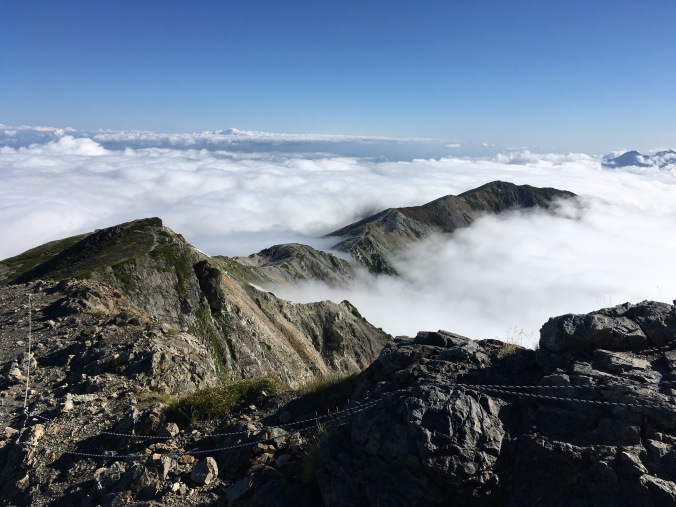
Dragon’s backbone of Mt. Korenge (View from summit of Mt. Shirouma)
After an initial steep decent, it was an easy and flat walk on crushed rock the size of large gravel. I passed by large cairns lurking mysteriously in the fog. The white rock changed to red, indicating iron content. My map showed a side trail leading on to the site of an old refinery and mine office.
The rocks on the slope up Mt. Korenge tinkled like glass when I walked over them. I picked one up and it felt lighter than it looked. An almost pumice. Atop Mt. Korenge, I took a break for a second breakfast of coffee, nuts and salami. I packed out an abandoned tupperware that obviously had held someone’s lunch in it. (It was a nice tupperware, but I was afraid to open it to wash it out and ended up just throwing it away when I got down to the gondola station at Tsugaike.)

Mt. Shirouma behind me
At Hakuba Oike Hut, I picked up some water (free!) and admired the flat campground looking onto an alpine meadow. Should be pretty on a clear day. Where is the pond? I followed the sign for Tsugaike to the other side of the hut and see the edge of the water in the mist and the trail going around the pond. After following the trail for the while, I think, this is a huge pond! More like a lake? I could only see the edge of the clear green water but it feels like the trail has been going around it for quite a while. The trail becomes some pretty fun rock hopping with occasional X and O symbols directing the way. It was like this all the way to the top of Mt. Norikura, which is not much of a peak but the high point on a flat mountain top. (No use hiking here to snowboard down, you’d just be stuck!) Finally, the sky opens just briefly enough for me to see the whole Hakuba Oike pond and take a photo.

Hakuba Oike pond
There was more rock hopping until I reached a small snowfield, and after the snowfield the rock hopping got quite a bit more challenging. Climbing down big boulders with a heavy pack on is much more difficult than with only a day pack, because you don’t want to destroy your knees and ankles from impact. Finally, finally, I reached the raised wooden platforms set over a marsh I’d been spying from up above.
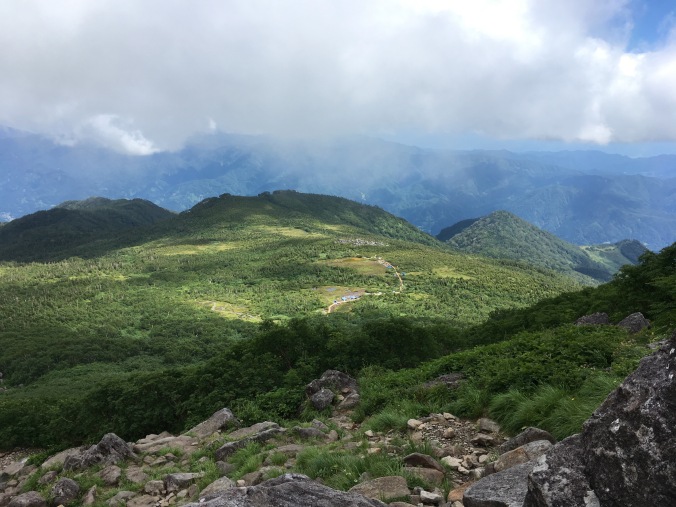
The wooden walkway was being replaced, and there were pallets of new wood to be installed off to the sides of the pathway. I hopped over onto one of the pallets and made myself comfortable. Since I didn’t really pack lunch for this last day, I end up cooking half a pack of quick cook pasta and a cube of kimchi jigae soup, since that’s what I have left. Yes, I have become one of those Japanese hikers that cooks hot lunch!

Lunch break!
As I was packing up after my lunch break, one of the workmen made his way over and asked me when I was heading down. He was looking for someone to walk down with. I’m a little weirded out initially, but he started telling me about his job. He and his team have been up at Tsugaike since July living in two trailers by the top of the Tsugaike ropeway. His company also did the wooden walkways at Happo-Ike, which I passed the first day of my hike, as well as at Mt. Naeba and Mt. Hotaka. I commented that it was a nice job to be able to work in all those beautiful places. He replied that he only comes to the mountains to work, his hobby is golf. He pointed out some bear scat on the trail. I haven’t seen a bear while in Japan yet!
We ran into a hiker testing the water at a spring. This water is safe, he called out to us, so we stopped for a drink and a chat. This typical retiree hiker explained he thought it would be boring to just set a goal of climbing the Hyakumeisan, so his personal goal is to test all the water sources on the Hyakumeisan. He says that so far, all the water sources he’s tested have been potable. Good to know right?

Guided by someone who’s walked up and down the trail everyday for months, I made it down to Tsugaike ropeway safely, with no injuries and finished my hike in good time. After getting to the bottom of Tsugaike Ski Resort, I consulted the bus schedule. I could’ve either hopped a bus direct from Tsugaike back to Tokyo, but I ended up busing back to Happo Bus Terminal where busses are more frequent so I could catch an onsen before returning to Tokyo.

The ski resorts of Hakuba Valley come into view

Tsugaike Gondola, the end of my hike
Logistics and Costs
I picked Hakuba for this last minute hike because the logistics were easy. I took a highway bus to and from Shinjuku, ski resort gondolas and lifts to and from the trail heads, and one of the Hakuba town buses from Tsugaike back to Happo Bus Terminal.
Shinjuku <–> Happo Bus Terminal Highway Bus: 8700 yen round trip
Happo-One Ski Resort: one-way up Adam Gondola – 1550 yen (1400 yen if you have a jRO search and rescue insurance card)
Tsugaike Ski Resort: one-way down the ropeway – 1360 yen
Tsugaike –> Hakuba bus: 560 yen
Tent site at Mt. Karamatsu: 1000 yen
Tent site at municipal Shirouma Hut: 1000 yen
Trip Tips
I wouldn’t have done Kaerazu no Ken by myself if it was raining. If it had been raining that morning at Mt. Karamatsu, my Plan B was to go south to Mt. Goryu, instead of north to Mt. Shirouma, because that ridge is less dangerous. Kaerazu no Ken was pretty sketchy and since I was alone, I was very careful and it took me 1.5 times the estimated course time on the map to complete it, because I didn’t want to lose my grip or footing anywhere and fall into an abyss…
There are two huts at the top of Mt. Shirouma, Hakubadake Chojo Shukusha (白馬岳頂上宿舎) and Hakuba Sanso (白馬山荘). Hakuba Sanso does not have tent sites.
There is free water at Tengu Hut, Hakubadake Chojo Shukusha and Hakuba Oike Hut, but not at Happo Ike Hut or Karamatsudake Hut.
I love this! Really informative, I want to try and hike this course now! What time of year did you go?
LikeLike
Oh August! Nice! Do you remember what temperature?
LikeLike
It was around 5 degrees Celsius at 5:30 AM the second morning on Shiroumadake.
LikeLike
Amazing! I’m planning on doing a similar Shirokuma route and trying to decide if I should bring inflatable sleeping pad or foam. Seems pretty rocky and everyone brings foam – is that what you’d recommend?
LikeLike
The designated campsites are flat so either way you will be fine. In my hiking life I have upgraded to an insulated inflatable pad (REI co-op Flash Pad) because it’s warmer.
LikeLike
Can we camp around the hut evem thought it doesnt jave campsite?
LikeLike
Unless the hut has a designated campsite, you cannot camp around the huts. The huts are staffed so you can’t stealth camp. The terrain in the area is such that it will be difficult to find a free campsite (i.e. a good patch of flat ground). Also, leave no trace principles in such highly trafficked alpine terrain suggest you should not try to make an undeveloped campsite.
LikeLike